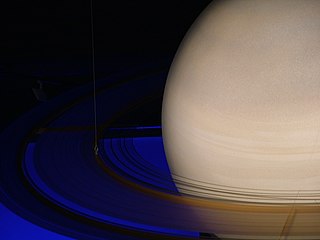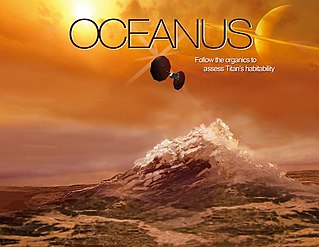Related Research Articles

The Mariner program was conducted by the American space agency NASA to explore other planets. Between 1962 and late 1973, NASA's Jet Propulsion Laboratory (JPL) designed and built 10 robotic interplanetary probes named Mariner to explore the inner Solar System - visiting the planets Venus, Mars and Mercury for the first time, and returning to Venus and Mars for additional close observations.

Mariner 9 was a robotic spacecraft that contributed greatly to the exploration of Mars and was part of the NASA Mariner program. Mariner 9 was launched toward Mars on May 30, 1971, from LC-36B at Cape Canaveral Air Force Station, Florida, and reached the planet on November 14 of the same year, becoming the first spacecraft to orbit another planet – only narrowly beating the Soviet probes Mars 2 and Mars 3, which both arrived at Mars only weeks later.

Titan is the largest moon of Saturn and the second-largest in the Solar System, larger than any of the dwarf planets of the Solar System. It is the only moon known to have an atmosphere denser than the Earth's, and is the only known object in space other than Earth on which clear evidence of stable bodies of surface liquid has been found.

Cassini–Huygens, commonly called Cassini, was a space-research mission by NASA, the European Space Agency (ESA), and the Italian Space Agency (ASI) to send a space probe to study the planet Saturn and its system, including its rings and natural satellites. The Flagship-class robotic spacecraft comprised both NASA's Cassini space probe and ESA's Huygens lander, which landed on Saturn's largest moon, Titan. Cassini was the fourth space probe to visit Saturn and the first to enter its orbit, where it stayed from 2004 to 2017. The two craft took their names from the astronomers Giovanni Cassini and Christiaan Huygens.

The Pioneer Venus project was part of the Pioneer program consisting of two spacecraft, the Pioneer Venus Orbiter and the Pioneer Venus Multiprobe, launched to Venus in 1978. The program was managed by NASA's Ames Research Center.

Huygens was an atmospheric entry robotic space probe that landed successfully on Saturn's moon Titan in 2005. Built and operated by the European Space Agency (ESA), launched by NASA, it was part of the Cassini–Huygens mission and became the first spacecraft to land on Titan and the farthest landing from Earth a spacecraft has ever made. The probe was named after the 17th-century Dutch astronomer Christiaan Huygens, who discovered Titan in 1655.

A microwave radiometer (MWR) is a radiometer that measures energy emitted at one millimeter-to-metre wavelengths (frequencies of 0.3–300 GHz) known as microwaves. Microwave radiometers are very sensitive receivers designed to measure thermally-emitted electromagnetic radiation. They are usually equipped with multiple receiving channels to derive the characteristic emission spectrum of planetary atmospheres, surfaces or extraterrestrial objects. Microwave radiometers are utilized in a variety of environmental and engineering applications, including remote sensing, weather forecasting, climate monitoring, radio astronomy and radio propagation studies.

STS-66 was a Space Shuttle program mission that was flown by the Space Shuttle Atlantis. STS-66 launched on November 3, 1994, at 11:59:43.060 am EDT from Launch Pad 39-B at NASA's Kennedy Space Center. Atlantis landed at Edwards Air Force Base on November 14, 1994, at 10:33:45 am EST.

The Upper Atmosphere Research Satellite (UARS) was a NASA-operated orbital observatory whose mission was to study the Earth's atmosphere, particularly the protective ozone layer. The 5,900-kilogram (13,000 lb) satellite was deployed from Space Shuttle Discovery during the STS-48 mission on 15 September 1991. It entered Earth orbit at an operational altitude of 600 kilometers (370 mi), with an orbital inclination of 57 degrees.

The Lunar and Planetary Laboratory (LPL) is a research center for planetary science located in Tucson, Arizona. It is also a graduate school, constituting the Department of Planetary Sciences at the University of Arizona. LPL is one of the world's largest programs dedicated exclusively to planetary science in a university setting. The Lunar and Planetary Lab collection is held at the University of Arizona Special Collections Library.

Over the last two centuries many environmental chemical observations have been made from a variety of ground-based, airborne, and orbital platforms and deposited in databases. Many of these databases are publicly available. All of the instruments mentioned in this article give online public access to their data. These observations are critical in developing our understanding of the Earth's atmosphere and issues such as climate change, ozone depletion and air quality. Some of the external links provide repositories of many of these datasets in one place. For example, the Cambridge Atmospheric Chemical Database, is a large database in a uniform ASCII format. Each observation is augmented with the meteorological conditions such as the temperature, potential temperature, geopotential height, and equivalent PV latitude.

The exploration of Saturn has been solely performed by crewless probes. Three missions were flybys, which formed an extended foundation of knowledge about the system. The Cassini–Huygens spacecraft, launched in 1997, was in orbit from 2004 to 2017.

The atmosphere of Titan is the dense layer of gases surrounding Titan, the largest moon of Saturn. It is the only thick atmosphere of a natural satellite in the Solar System. Titan's lower atmosphere is primarily composed of nitrogen (94.2%), methane (5.65%), and hydrogen (0.099%). There are trace amounts of other hydrocarbons, such as ethane, diacetylene, methylacetylene, acetylene, propane, PAHs and of other gases, such as cyanoacetylene, hydrogen cyanide, carbon dioxide, carbon monoxide, cyanogen, acetonitrile, argon and helium. The isotopic study of nitrogen isotopes ratio also suggests acetonitrile may be present in quantities exceeding hydrogen cyanide and cyanoacetylene. The surface pressure is about 50% higher than on Earth at 1.5 bars which is near the triple point of methane and allows there to be gaseous methane in the atmosphere and liquid methane on the surface. The orange color as seen from space is produced by other more complex chemicals in small quantities, possibly tholins, tar-like organic precipitates.

The Solar Backscatter Ultraviolet Radiometer, or SBUV/2, is a series of operational remote sensors on NOAA weather satellites in Sun-synchronous orbits which have been providing global measurements of stratospheric total ozone, as well as ozone profiles, since March 1985. The SBUV/2 instruments were developed from the SBUV experiment flown on the Nimbus-7 spacecraft which improved on the design of the original BUV instrument on Nimbus-4. These are nadir viewing radiometric instruments operating at mid to near UV wavelengths. SBUV/2 data sets overlap with data from SBUV and TOMS instruments on the Nimbus-7 spacecraft. These extensive data sets measure the density and vertical distribution of ozone in the Earth's atmosphere from six to 30 miles.

ADEOS I was an Earth observation satellite launched by NASDA in 1996. The mission's Japanese name, Midori means "green". The mission ended in July 1997 after the satellite sustained structural damage to the solar panel. Its successor, ADEOS II, was launched in 2002. Like the first mission, it ended after less than a year, also following solar panel malfunctions.

Athena Coustenis is an astrophysicist specializing in planetology. Dr. Coustenis, a French national, is director of research, Centre national de la recherche scientifique, at LESIA, at the Paris Observatory, Meudon. She is involved in several space mission projects for the European Space Agency (ESA) and for NASA. Her focus is on gas giant planets Saturn, Jupiter and their moons, and she is considered a foremost expert on Saturn's moon Titan.

Oceanus is a NASA/JPL orbiter mission concept proposed in 2017 for the New Frontiers mission #4, but it was not selected for development. If selected at some future opportunity, Oceanus would travel to Saturn's moon Titan to assess its habitability. Studying Titan would help understand the early Earth and exoplanets which orbit other stars. The mission is named after Oceanus, the Greek god of oceans.

SPRITE was a proposed Saturn atmospheric probe mission concept of the NASA. SPRITE is a design for an atmospheric entry probe that would travel to Saturn from Earth on its own cruise stage, then enter the atmosphere of Saturn, and descend taking measurements in situ.

Nimbus 3 was a meteorological satellite. It was the third in a series of the Nimbus program.

Nimbus 4 was a meteorological satellite. It was the fourth in a series of the Nimbus program.
References
- ↑ Irwin, Patrick (2009). Giant Planets of Our Solar System: Atmospheres, Composition, and Structure. Springer. p. 131. Retrieved 3 June 2014.
- 1 2 3 Beer, Reinhard (1992). Remote Sensing by Fourier Transform Spectrometry. John Wiley and Sons. p. 101.
- 1 2 Beer, Reinhard (1992). Remote Sensing by Fourier Transform Spectrometry. John Wiley and Sons. p. 102.
- ↑ Coustenis, Athena (2007). "What Cassini-Huygens has revealed about Titan". Astronomy & Geophysics. 48 (2): 2.14–2.20. Bibcode:2007A&G....48b..14C. doi: 10.1111/j.1468-4004.2007.48214.x .
- "Infrared Interferometer Spectrometer and Radiometer". voyager.jpl.nasa.gov. N.A.S.A. Retrieved 2018-08-04.